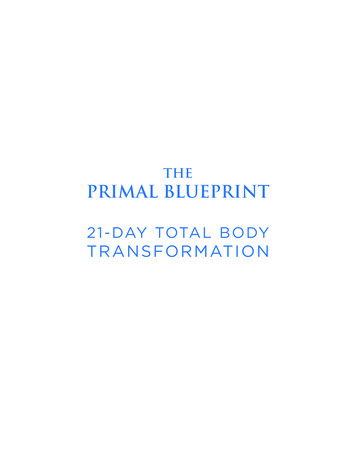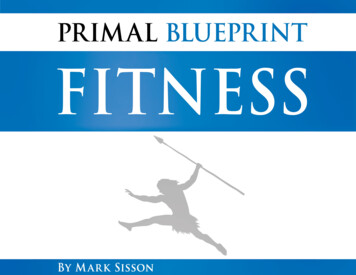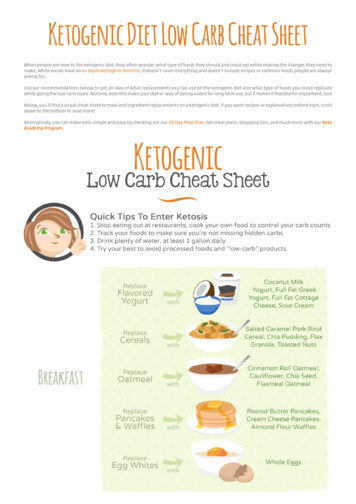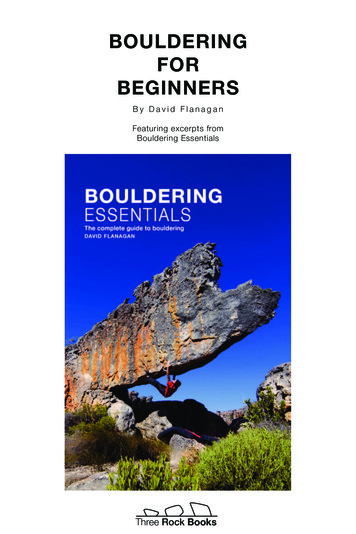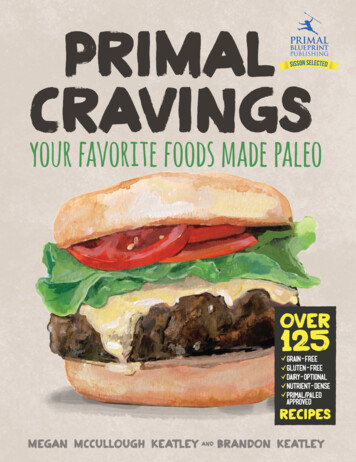
Transcription
PRIMAL CRAVINGSYOUR FAVORITE FOODS MADE PALEOMegan McCullough Keatley and Brandon Keatley
PRIMAL CRAVINGS 2013, Megan Keatley and Brandon KeatleyAll rights reserved. Except as permitted under the United States Copyright Act of 1976, reproduction or utilization of this work in any form or by any electronic, mechanical, or other means, nowknown or hereafter invented, including xerography, photocopying, and recording, and in any information storage and retrieval system, is forbidden without written permission of the publisher.This book is intended as a reference volume only, not as a medical manual. The information givenhere is designed to help you make informed decisions about your health. It is not intended as a substitute for any treatment that may be subscribed by your doctor. If you suspect you have a medicalproblem, we urge you to seek competent medical help.Mention of specific companies, organizations, or authorities in this book does not imply endorsement by the author or publisher, not does mention of specific companies, organizations, or authorities that they endorse this book, its authors, or the publisher. Information in this book was accurateat the time researched. The authors received no incentives or compensation to promote the itemrecommendations in the book.Library of Congress Control Number: 2013903303Library of Congress Cataloging-in-Publication Data is on file with the publisherKeatley, Megan McCullough 1985- ; and Keatley, Brandon, 1983Primal Cravings / Megan McCullough Keatley and Brandon KeatleyISBN: 978-0-9847551-9-61. Cooking 2. Health 3. Diet 4. Low carbEditor: Jessica Taylor TudzinCopy Editor: Nancy Wong BryanDesign and Layout: Megan McCullough Keatley and Caroline De VitaCover Design: Janée MeadowsIllustrations: Danna RayPhotos on page 8, 11, 36, 37 and back cover: Jodi Jones PhotographyFood photography: Megan McCullough KeatleyPublisher: Primal Blueprint Publishing. 23805 Stuart Ranch Rd. Suite 145 Malibu, CA 90265For information on quantity discounts, please call 888-774-6259 or visit PrimalBlueprintPublishing.com
acknowledgments and thank yousA heartfelt thank you to our families for making us who we are, and for all the great choices you’ve made inyour lives.Our greatest appreciation to Mark Sisson for being an inspiration and for making this book a reality.Shout out to our recipe tasters and testers—for your time, taste buds, and feedback.And last, but not least, we want to thank the readers of our blog, Health-Bent.com. Without your support,comments, and feedback, this book wouldn’t have been possible.disclaimerThe ideas, concepts, and opinions expressed in this book are intended to be used for educational purposesonly. This book is sold with the understanding that the authors and publisher are not rendering medical advice ofany kind, nor is this book intended to replace medical advice, nor to diagnose, prescribe, or treat any disease,condition, illness, or injury. It is imperative that before beginning any diet or exercise program, including any aspectof the diet or exercise methodologies mentioned in Primal Cravings, you receive full medical clearance from alicensed physician. The authors and publisher claim no responsibility to any person or entity for any liability, loss,or damage caused or alleged to be caused directly or indirectly as a result of the use, application or interpretationof the material in this book. If you object to this disclaimer, you may return the book to publisher for a full refund.
contentswelcome8our philosophy.12building an umbrella.18home run recipes and winning results.25the 80/20 rule.26ingredients30tools & equipment38stocking the kitchen42rise ’n’ shine44hazelnut coffee pancakes. 46strawberry shortcake waffles. 48cherry almond streusel muffins. 50honey nut crunch. 52gingerbread muffins. 54biscuits. 56honey butter. 56chunky monkey muffins. 58dairy-free strawberry yogurt. 60cowboy hashbrown skillet. 62sausage & eggs to go. 64western omelette to go. 66caprese baked eggs. 68smoked salmon hash. 70tangy dill vinaigrette. 70bacon ten ways. 73meats & mains74coconut shrimp cakes. 76pineapple salsa. 76crawfish étouffée.78seafood pot pie with cheddar crumble biscuit. 80pastrami salmon. 83shrimp pad thai. 84gyro taco salad & tzatziki guacamole. 86spanakopita soup. 89moo shu cabbage cups. 90best-ever pulled pork. 92cuban burger. 94spaghetti squash carbonara. 96balsamic & arugula pizza with prosciutto . 98butternut squash lasagna. 100loaded fauxtato soup. 102chorizo stuffed pork chops. 104bacon lattice & tomato sandwich. 106chicken enchilada empanadas. 108sweet & sour split roast chicken. 110crispy chicken fingers. 112thai chili chicken meatballs. 114hot & sour chicken noodle soup. 116tikka masala chicken wings. 118curry turkey burgers & mango slaw. 120buffalo chicken salad. 122chili pie. 124italian fajitas & bruschetta salsa. 126pumpkin chili & zesty guacamole. 128philly stuffed peppers. 130chili dog chili. 132all-american burger. 134steak & eggs tartare. 136sloppy joe meatballs. 138chicago dog skewers. 140swedish meatloaf. 142barbacoa pot roast. 144sides & salads146antipasto salad. 148sweet roasted red pepper basil vinaigrette. 148broccoli salad. 150caesar egg salad. 152tabouli salad. 154tequila, lime & green onion slaw. 157moroccan carrot salad. 158roasted squash & beet salad. 161mediterranean pasta salad. 162chimichurri smashed plantains. 164maple, orange, chipotle sweet potato crisp. 167coconut curry chowder. 168mustard roasted asparagus. 170baba ghanoush gratin. 172browned butternut squash & sage purée. 174curried creamed spinach. 177root risotto. 178ranch potato salad. 180
snacks182rosemary & garlic parsnip chips. 184bloody mary pickled tomatoes. 186benedict deviled eggs. 188pizza bites. 190lunch able. 193bacon & guacamole pepper poppers. 194cheese crackers. 196beef jerky three ways. 198barbecue fauxtato chips. 200olive oil focaccia. 202everything crackers. 204b-butter. 206trail mix cups. 208juicy jigglers. 210sweets212open-faced apple pie. 215blueberry pastry pies. 216maple pecan pie squares. 218mango orange cream pops. 220strawberry lemonade pudding. 222cherry limeade sorbeta. 224chocolate almond gelato. 226caramelized banana milkshake. 228thin mints. 230chocolate coconut scout cookies. 232thick & chewy chocolate chip cookies. 235thin & crispy chocolate chip cookies. 235double chocolate espresso cookies. 236carrot cake cream pies. 238brownies. 240dirty blondies. 242caramel coconut cupcakes. 244no-bake granola bars. 246almond happiness fudge. 249devil’s food snack cake. 250maple banana spice cake. 252basics254bread. 256croutons. 258pizza crust. 259caesar dressing. 260bacon honey mustard. 260greek dressing. 260ranch dressing. 261thousand island. 261italian dressing. 261mayonnaise. 262pizza sauce. 263country breakfast sausage. 264italian sausage. 265chorizo sausage. 266salsa. 267resources268recip easy menus.271nutrition index.274index280
WelcomePrimal Cravings has been in the making for nearly a decade. It isn’t that we’ve beendeveloping the recipes for that many years; it’s because this book ultimately representsour growth as individuals, and as a couple. The influence we’ve had on each other hasshaped what we believe in and how we go about daily life. Good food is our commonground!But we haven’t always defined “good food” in the same way. We met in college atthe University of South Carolina in 2004. While pursuing a corporate finance degree,Megan worked as an executive pastry chef in the kitchen of one of South Carolina’stop fine-dining bistros, whipping up cakes and tarts, crème brûlées, soufflés, breadpuddings, and ice creams. To Megan, food was much more than nutrition. It was anart form. It was a way to express creativity and enjoy every aspect of the process, fromkitchen to table. Brandon saw it differently. A student of engineering with a love forall kinds of sports and fitness pursuits, he regarded taste, texture, and savoriness asinconsequential as long as food provided high-quality fuel for the body. As you mightimagine, our wildly differing approaches to food led to some serious contention as webegan spending more time with each other, and consequently sharing more meals.Gradually, mutual respect won out. After all, we each had valid points. And sobegan our foray into planning and cooking meals together, creating cuisine that wasas artistic, flavorful, and enjoyable as it was nourishing and life-giving. Eventually themonths gave way to years and now here we are, married and cooking meals that webelieve are far superior than anything either one of us could have previously imaginedback in those early years.Our opinion on what a healthy lifestyle means has evolved as well. When we firstmet, we both subscribed to the low-fat, calorie-conscious diet prescribed by conventional wisdom. However, in 2006, we discovered the Primal/paleo lifestyle. Aftermuch research and investigation into this seemingly radical new approach, we startedto accept the idea of bucking the status quo. But as with anything new and different,we weren’t willing to accept everything at face value. We spent years digging deeper,9
gaining a better understanding and refining what Primal/paleo means to us. As we’lldetail in the next section of this book, we distilled our research and created a place toshare all that we learned on the web.When we launched Health-Bent.com, we were out to prove that a diet absent ofstaples from the standard American diet needn’t leave anyone feeling deprived. Youmight even say we were hell-bent on it! In the years since we started the site, it’s grownorganically into something we’re very proud of, offering healthful alternatives to thefoods you thought you couldn’t eat. We like to say Primal Cravings is “food you wantto want to eat.” That is, nutrient-dense food that you can really get excited about eating. Sure, grilled chicken over a salad can be tasty. But creating a lifelong passion forhealthful eating requires more variety, more soul.In addition to running Health-Bent, we are both CrossFit coaches, teaching Primal/paleo principles and guiding our clients through their transition to cleaner and moreenjoyable eating. The folks we work with on a daily basis confirm that our ideas workin the real world. Based on their feedback and results, they have experienced profoundlifestyle changes by using recipes that offer variety and flexibility.We know our nutrient-dense diet has us feeling and performing better than ever,too. In 2012, we competed together on our affiliate team and placed 7th in the CrossFit Games Southeast Regional.When we aren’t coaching or training, we enjoy traveling and doinghome improvement projects. Butmost of our time at home is spentlearning more about nutrition andcooking, and, of course, creatingdelicious recipes that have it all.It’s who we are.10
our philosophyWe like to eat good food, plain and simple. We also like to feel great and be healthy and productive.We do not believe that these two things have to be mutually exclusive.12
Whether they are comforting to us, are associated with fond memories, or stem fromcuriosity to find variety and seek out new tastes, the desire for flavorful foods is universal. But we also want our food to be nourishing. It’s in that spirit that we set outto provide the best of both worlds, with foods that satiate our deep-seated, visceralurges, made from ingredients that satisfy our ancient, genetic needs for good health.We’re talking about outstanding flavors that you may already know and love, oftenwith an interesting—and healthier—twist. It’s as simple as omitting the unhealthyingredients in your favorite foods by changing the vehicle that delivers the flavors. Forexample, you’ll find many of the ingredients and all of the flavor of a Philly cheesesteaksandwich in our Philly Stuffed Peppers recipe. Same thing with the Chicago dog thatwe’ve transformed into a kebab. The end result is the best food we’ve ever made, andwe’re excited to bring it to your kitchen.Guided by PRIMAL/PALEO PrinciplesFun, tasty, and flexible recipes are this book’s primary intent. The recipes are guided byprinciples that also make them healthy choices, so we’d be remiss if we didn’t touchon what those principles are and how we use them.Perhaps you’re already familiar with the Primal/paleo movement. Or maybe youare just coming to know about it. For the sake of convenience, we offer the followingprimer.The Primal/paleo way of eating is, at its core, about finding the perfect human diet.We look to evolution for answers, adapting a diet informed by the past, thus providingour homo sapiens genes the influences they “expect” for optimal health.The terms Primal and paleo refer to the diets of our primitive ancestors. Research13
by evolutionary biologists and anthropologists suggest that during the Paleolithic Era,obesity, cardiac disease, diabetes, high blood pressure, and many other diseases eitherdid not exist or were many orders of magnitude less prevalent than they are today. Wecommonly refer to our Paleolithic ancestors as hunter-gatherers because they had notyet adopted an agrarian (agricultural-farming) lifestyle and obtained their food from,well, hunting and gathering.Our ancestors were exceptionally fit and healthy by today’s standards—they had tobe in order to survive! And while their life expectancy was low due to the primitive dangers and health hazards they faced (as well as a complete lack of medical care), thosewho avoided rudimentary traumas commonly lived six or seven decades in robusthealth!Genetically speaking, we are still identical to our Paleolithic ancestors. But unlikethem, we are plagued by widespread disease and obesity, despite all our moderninformation and conveniences. And the problem seems to be getting worse each year,raising the question: What has gone so terribly wrong since Paleolithic times?When we speak of Primal/paleo, we are essentially talking about informing our dietswith the foods from which our species evolved over 2.5 million years. These foodssupply all the macro and micro nutrition that the human body needs to thrive. As MarkSisson reminds us in his book, The Primal Blueprint, the principles of Primal/paleo arenot new, but “as old as the dawn of mankind, reinforming us about the fundamentalsof health that seem to have been forgotten, or misinterpreted, in the modern world.”It’s pretty simple stuff, really. But don’t let that fool you into thinking there is no variety. When we examine indigenous peoples who live similarly to our ancestors, we seethat their diets vary greatly with the climate and geography. That is to say, there is nosingle ideal diet. For example, some people, such as the traditional Inuit in the Arctic,subsist on a high-fat, high-protein diet, made up mostly from whale, seal, walrus, andcaribou. Others, such as the Tukisenta people of Papua New Guinea, thrive almostexclusively on starchy tubers. Yet both groups, as well as many other hunter-gatherersocieties throughout the world and throughout history, live or have lived essentially freeof disease with naturally lean bodies. Regardless of the variation in diets, the universalcharacteristics among them all still boil down to two types of food: edible plants andanimals.So, is there more to it than a romantic idea of a time free of cancers, heart disease,diabetes, and the like?We’re glad you asked. Yes, there is a whole lot more. As mentioned, a Primal/paleodiet provides the template for optimal living. It leads us down a path to vibrant healththat modern science can substantiate. Though we may think some of the staple foodswe consume today—grains, for instance—have been with us a long time, the truth issuch foods have been available to us a relatively short time in our 2.5 million-year-oldevolutionary history (we’re talking .004 percent!), so we haven’t evolved any complexadaptations to process them effectively.Along with anthropology, we also turn to science for answers, asking: What’schanged? What’s new? What modern foods can we enjoy without evolutionary penalty?14
Hippocrates taught us to letfood be our medicine, a principleSay the food you are making at home isfully embraced by the Primal/paleohealthy, but, well, kind of boring. Maybecommunity. When we eat the wayit lacks depth, surprise, or emotion. Howour ancestors did, we allow ourmuch more likely would it be for you tofood to return us to good health.fall prey to all the guilty pleasures outIn addition to medicine, food actsthere—the comfort food, the fast food,as information. Once food entersthe packaged junk food—just waiting onour bodies, our cells are informedyour moment of weakness when you getabout the conditions of the extea hankering for something rich, yummy,rior environment, and in reaction toand soul-satisfying? It’s the kind of thingthat information, our cells respondthat could have you falling out of lovewith your healthy lifestyle very quickly.accordingly, either activating orWe would not be ashamed to say that wedeactivating certain genes that willwould likely fall face first into somethingallow us to adapt to the currentlike that ourselves if we had nothing tocircumstances. There is nothing insatisfy us at home.our environment that has no influWe call these wanderings off the regimenence on our genes. The sunlight“flavor cravings.” Seeking palatabilitywe receive, our activity level, theis a very basic craving we all have, andamount of stressful or relaxing situthe ability to enjoy something otherwiseations we regularly encounter, andutilitarian (fuel/energy/nutrients) really isyes, even, and most especially, thesomething that makes us human. Denyingfoods we eat, they all serve as inforourselves pleasurable food not onlymation.goes against our nature, but is unjustlyWhat this means is that whileimpractical compared to eating mindfully.ourgenetic code (DNA) is fixed andFor that reason we’ve created healthfulalternatives to compete with the unhealthyunchanging, the ways our genesall-American favorites out there. It’s allare signaled are not. A field of studyabout staying healthy while enjoying life.called epigenetics sheds light onhow all this works. Essentially, ifwe think of our genes as computer hardware (our physical computer), then the environment is the computer software(computer programs) that tell our genes what to do. This is known as “gene expression.”A study by the Spanish National Cancer Center illustrated the environmental effectson our genes when it found that the more separate and the more different the lifestylesof identical twins, the less their gene expressions had in common—even though thetwins possessed identical DNA! In some twins, one was diagnosed with cancer whilethe other remained cancer-free.All of us have strong predispositions coded into our familial genes. Some of us evenhave a genetic predisposition for obesity, arthritis, or other such maladies. But evengenetic bad luck requires a lifestyle component to play out—without that influence, itwill likely lie dormant. And in the same way, the genetic recipe for the perfect humanFLAVOR CRAVINGS16
being, standing proud after conquering more than two million years of selection pressure resides in each one of us. All you have to do is deliver the proper environmentalsignals to experience your personal potential, and (no matter how bad your familialgenes are) skate right past the health problems caused when genetic predispositionsencounter adverse lifestyle practices.So, the bad news is we can’t use our genes as an excuse anymore; the good newsis, we can’t use our genes as an excuse anymore! Your fate is not predetermined—it’sup to you! Without a doubt, the Primal/paleo way of eating promotes optimal geneexpression. But this need not be a reenactment of days gone by. You have the flexibilityto strike your own balance and work around your personal preferences. It’s just a matter of sorting out which of today’s foods are beneficial and which are not. Once you dothat, technology and progress can work to your benefit instead of your detriment.To get started, let’s build a model that shows the relationship of all of the factors atplay. Think of it as a rebuttal to the USDA’s Food Pyramid or My Plate, except insteadof simply having an unsubstantiated list of food groups and serving suggestions, weprovide a set of guidelines on what foods to eat, minimize, and totally avoid.THE STORM CLOUDFirst, let’s define the goal. We’ll make the assumption that yours is similar to ours: tolive a long, happy, productive, disease-free life.CrossFit founder Greg Glassman describes health as a continuum ranging fromsickness to optimal fitness, with everything in between representing various degrees ofillness to wellness.On the extreme end, a poordiet can cause heart disease, cancer, type 2 diabetes, autoimmuneconditions, hormone imbalances,and depression. Less severe butstill undesirable conditions includeacne, low energy, poor sleep, andweight gain.Think of these ailments combined into an ominous storm cloud.For some of us, that dark cloudmight have already moved overhead and is pouring down a hostof medical problems. Or perhapsyou sense a storm brewing on thehorizon. We hope you’re currentlyexperiencing clear skies and wantto implement preventive measures.But whatever your current climate,you need protection.17
BUILDING AN UMBRELLATHE HANDLENaturally, one of the best ways to shelter yourself from a storm is with an umbrella. Anumbrella consists of a handle, ribs, and fabric. Similarly, so should your diet. For ourfigurative umbrella, the handle represents the Primal/paleo lifestyle and the modern science that supports it. Together, they give us the confidence that makes intuitive sense.It’s something we can believe in, that we cangrab on to and posture overhead in a confusing world made up of conflicting fads, dietprescriptions, and marketing noise.In the last decade, study upon studyaffirms the health benefits of a natural,nutrient-dense, low-glycemic diet that thePrimal/paleo diet affords. The healing benefits include increased energy, weight loss,improved muscle tone, relief from joint pain,lowered blood pressure, reduced liver fat,and improved insulin sensitivity. The substantiating research continues to build as peoplewho switch to a Primal/paleo diet are seeingoutstanding results in virtually all health markers.Now, let’s add a few ribs to our umbrella to give it some structure.THE RIBSThe ribs of our umbrella represent our nutritional priorities. They’ll lead us to the bestPrimal choices and away from what we call “agents of disease.” Instead of listing thethousands of foods you “can eat”—without compelling evidence as to why they shouldbe included or excluded—we’ll focus on the five nutritional priorities that establish whatto embrace, what to minimize, and what to completely avoid.1. Eat nutrient-dense, whole foods2. Eliminate grains and legumes3. Minimize sugar and moderate total carbohydrate intake4. Know your fats, good from bad5. Shop for the bestRib #1: Eat Nutrient-Dense, Whole FoodsHard to argue that fresh meat, fruit, and veggies pack a greater nutritional punch thanthose processed for a long shelf life. We’re talking nutrient-dense foods sourced directly from the land, the kind available throughout most of human evolution, when thosewere the only things considered food.18
These same basic foods occupy the exterior of your grocery store,where the electrical outlets are located,because they are fresh and in manycases need refrigerating or freezing.High-quality, whole foods are alsofound at farmers markets (and directlyat the farm!). This is not to say that anyand all processing is bad, because ina sense cooking is processing—andobviously we are all for cooking. We’rejust implying that the majority of yourfood should start as fresh, unprocessed, and unrefined. Whole foodsthat have been minimally processedthrough preserving, pressing, fermenting, or drying and grinding are perfectlyhealthy, too.As for agents of disease, thesewould be foods that are far removed from their natural state—resembling nothing ourhealthy ancestors ate. In fact, when certain processed foods found their way into theindigenous diets of non-industrialized societies, the health of its citizens steadily beganto decline. So, good health is as much about what you eat as what you don’t.Think of a high-performance car. If a substance in the fuel causes the car’s engineto malfunction, the first thing you’re going to do is remove that substance, right? Seeking a remedy by adding anything else to the fuel just doesn’t make sense. Your bodyis the same way. If you are eating something that makes you ill, you must remove theoffending item before you can return to good health.As dramatic as this might sound, much of the foodstuff Americans (and others inthe industrialized world) eat and drink on a daily basis are loaded with toxins. Some ofthe toxins are harmful to us in any quantity. And others are toxic simply by virtue of thedose, meaning it’s within our body’s experience to remain healthy when exposed tosmall amounts of certain items. But in larger doses, we become ill.Rib #2: Eliminate Grains and LegumesGrains pretty much fall into the class tha
ties that they endorse this book, its authors, or the publisher. Information in this book was accurate at the time researched. The authors received no incentives or compensation to promote the item recommendations in the book. Library of Congress Control Number: 2013903303 Library of Congre
